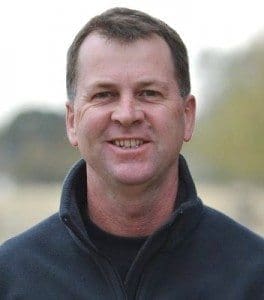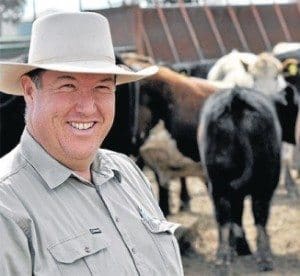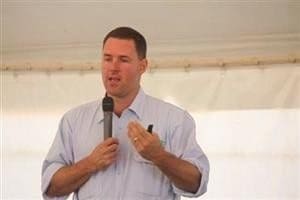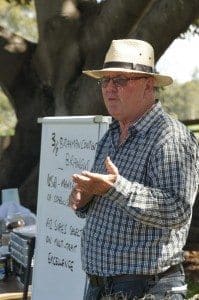WHILE Spring does not officially start for another month or more, the beef industry’s traditional Spring bull selling season is already underway, heralding the most condensed passage of bull transactions across Eastern Australia for the year.
Beef Central approached four of the best known genetics and bull-buying consultants operating across the Eastern states to gauge their opinion about the prospects for the selling season that lies ahead.
Will the current spike in commercial cattle prices pull bull buying sentiment along with it? Will there be too many bulls on the market, following the sustained liquidation in commercial breeder herds due to drought?
While there’s already been a couple of early sales completed in late July, fixtures in most areas of Eastern Australia are only getting underway this week. Early indications look encouraging: Greg Chappell’s Dulverton Angus near Dungog sold 69 bulls last week averaging $6442, up about $1400 a head on last year, while the New England Angus Breeders sale saw 46 bulls average $6228.
One of the common factors that all four bull-buying consultants mentioned in discussions with Beef Central was the strong ‘trade-in’ value on used herd bulls this year. One contact in recent weeks had sold a couple of heavy Limousin bulls (+900kg), for 269c/kg liveweight to the meatworks, returning more than $2400 each. That puts a hefty deposit into the account to provide a head-start when buying herd bull replacements.
Here’s what our expert panel members (Albury’s Brian Cumming, Forbes’s Jeff House, Tamworth’s Alastair Rayner and Queensland’s Don Nicol) see for the season ahead:
Brian Cumming, Brian Cumming Agriculture, Albury:
 Brian Cumming provides genetics and bull buying advice to clients across Victoria and southern regions of NSW. He says the first few ‘spring’ sales in his region will take place this week.
Brian Cumming provides genetics and bull buying advice to clients across Victoria and southern regions of NSW. He says the first few ‘spring’ sales in his region will take place this week.
“While there’s been lots of talk about females having been sold-down this year, I think demand for bulls will remain strong this spring selling season,” Mr Cumming said.
I’d expect commercial producers will have to pay perhaps $1000 to $1500 more for bulls this year
“As was evident in the autumn bulls sales held earlier, I’d expect commercial producers will have to pay perhaps $1000 to $1500 more for spring bulls this year – for the same good quality bull that they would have bought 12 months ago.”
“That’s being driven both by general cattle market sentiment, with higher prices being paid for slaughter and store cattle, as well as a quality demand factor.”
“Price rises like that might not be seen across the board, but I can see it applying to good quality herd bulls, where the demand is likely to be highest.”
Asked whether local studmasters had culled any harder for this year’s sales, in the expectation that commercial cow numbers were likely to be down, Mr Cumming thought that probably did not apply, in his particular area.
“We’re going to see a lot of bulls put in front of buyers across this spring – I don’t think numbers offered will vary much from last year – and my expectation is that most of them will be sold,” he said.
He said he was not convinced that local bull buyers would necessarily spend more on bulls, just because there was a bigger pay-check for cull bulls this year. “They’re happy to trade those old bulls in for better money, but I don’t necessarily see that reflected in their approach to pricing new bulls. Rather, they have a price in mind, and a quality level in mind, and I’m not sure that they consciously put the two together.”
Jeff House, Jeff House Livestock, Forbes, Central NSW:
 Jeff House anticipates that the average prices for decent herd bulls will go up this year – “at least a little, and perhaps more than that,” he said.
Jeff House anticipates that the average prices for decent herd bulls will go up this year – “at least a little, and perhaps more than that,” he said.
“Given current cattle pricing, commercial beef producers will have confidence to go out and buy good herd bull replacements. The trade-in-value on old cull bulls will obviously help that,” he said.
“I’d expect it will be general strength in the bull market. Whether it has much impact at the top end of the market is less certain, but I’d expect to see plenty of people taking the opportunity to trade-in some older bulls and try to improve the genetics in their herd a little, by picking up some younger mid-priced replacements.”
“From that perspective, I think the middle segment of the market will be really strong, and should push clearance rates along.”
Mr House said the signals that bull breeders had received for the past couple of years had been to ‘definitely reduce’ offering numbers, as commercial cow numbers across Eastern Australia declined.
Given current cattle pricing, commercial beef producers will have confidence to go out and buy good herd bull replacements
“When there is 400c/kg or more available out there for cows, turning them into $1200 or $1400 on the hook, it’s been hard for some people to hold back and not take that money now. The NSW cow kill has been unusually high now for the past six months.”
“There may well be a lag in being able to respond to higher bull demand this year, but it is hard to tell at this point. After all, the cattle market spike has only really taken place over the past three or four months, so it is impossible for bull breeders to react that quickly.”
One solution, if demand rises, might be for studs to offer a few more yearling bulls to fill any shortfall in supply. “More people understand the yearling bull option now, and there’s no reason why they can’t be successful, provided they are managed properly. But there’s still the lingering misconception that they can be bought as heifer bulls, thinking they will produce smaller calves.”
“So I’d be surprised if clearance rates in better stud herds aren’t close to 100pc this spring, at a realistic reserve price – I’d doubt there will be too many bulls at all selling for under $3000 this year.”
Alastair Rayner, Rayner Agriculture, Tamworth, NSW:
 “My gut feel is that the potential for a stronger bull market this year is definitely there. There’s a degree of optimism and confidence out there – not only in current commercial cattle prices, but people are confident that the market is going to hold-up,” Mr Rayner said.
“My gut feel is that the potential for a stronger bull market this year is definitely there. There’s a degree of optimism and confidence out there – not only in current commercial cattle prices, but people are confident that the market is going to hold-up,” Mr Rayner said.
He said while the season in the northwest of NSW had perhaps not completely turned around, it was much better than it had been.
“That general sense of optimism about cattle prices is also being buoyed by the better weather situation, so it’s not a bad environment to be selling bulls into. We’re seeing the transition out of this notion of buying $2000 bulls. Gradually, more people are changing their expectation about what’s reasonable to pay for good bulls going into a commercial herd.”
“There are more people who are prepared to pay at least $4500 to get the right animal – and that’s definitely being underpinned by the great resale value that’s out there for cull bulls these days.”
“It means that to upgrade into better genetics is a pretty cost- efficient process now, for a lot of those guys.”
“The drought over the past couple of years has put a lot of pressure on seedstock producers, as well as commercial cattlemen, in culling the bottom end of their registered breeding herds. But that’s meant that the bulls that are left are, on average, better quality than they would have been two or three years ago, before the culling process took place.”
There appears to be 4000-4500 bulls for sale in the region from Tamworth to the Qld border
“But there’s still a lot of bulls around, despite that stud herd reduction process. I went through a pile of catalogues on my desk the other day, and there appears to be 4000-4500 bulls for sale over the next couple of months, across all breeds, in the region from about Tamworth north to the Queensland border.
“There’s new players like Swan Vale which have not sold before, which are offering 45 or 50 bulls in their first year. It does not take long to rack-up some numbers, with new players emerging. There will still be plenty of bulls to go around.”
“But I don’t think people will go crazy this year, based on cattle prices. The strength in the market is likely to be for those good commercial herd improvers – not necessarily a standout trait leader – but a consistent, low-birthweight, moderate-framed bull with good growth figures that could go over a nice line of cows or a few b-grade heifers – those ‘bread-and-butter’ bulls.”
“If they are going to spend money, they might as well get a good bull or two, and I think that’s what most commercial bull buyers will aim to do this year.”
“If the season stays good and the market stays good, then next year might see people holding on to another 10-20pc of heifers, perhaps changing the scenario, in seeking a good heifer bull. But I think this year will be more about consolidating what people have, buying the best bulls they can, to a budget, and see what happens with the weather.”
“But lingering in the back of everyone’s mind is what the season is going to do. For a lot of people here, the season has been good to this point, but if they are paying down an overdraft, they may not have a lot left over to pay for a couple of bulls, despite the salvage value on old bulls.”
Don Nicol, Breedlink, Brisbane:
Well known Queensland genetics and bull buying consultant Don Nicol says this year, it’s likely that some producers hit by dry conditions and low prices in recent years may have to re-stock their bull battery, after perhaps ‘getting by’ for the past couple of joinings with what they had.
“In Queensland, there are still areas that are very dry, so while I think there will be significant and strong demand for bulls this year, those weather conditions are going to temper that.”
“But I don’t see that the 2015 years is going to break any records for bull averages, relative to the prices now being received for slaughter cattle.”
“Obviously, strong commercial cattle market prices inject a sense of optimism into the industry, but then people have to reach into their pocket, and after a couple of very tough years, I don’t think the bull market will go crazy.”
If they were in a financial position to do it, commercial cattle producers should be aiming to buy the best genetics they can this year, to set themselves up for the next few years, where prices for cattle looked like remaining very buoyant for a long time, Mr Nicol said.
“Buying good genetics is going to pay off in a productivity sense down the line, maximising the return from these higher cattle prices,” he said.
Early spring sales in coming weeks are likely to dictate the size of offerings later
Does that suggest that Queensland cattlemen and women will push their expectations further up the quality scale this year?
“In sales where there is good objective data provided, I think buyers this year will be looking more closely at it, because it represents dollars in the bank in a strong commercial cattle market.”
“In terms of carcase genetics, with current cattle prices and greater adoption of MSA and certified grassfed programs, there is now a lot of opportunity to get good payback. For those people who have not focussed on good carcase genetics, now is a good time to do so,” Mr Nicol said.
The big decline in breeding cow numbers in Queensland and NSW due to the drought was likely to see some moderation in numbers of bulls offered by many Queensland studmasters this year, he said.
“But the early spring sales in coming weeks are likely to dictate the size of offerings later. If there is big demand and strong prices at those early sales, stud breeders are likely to shift more bulls into the auction channel, rather than paddock sales.”
“But again, in Queensland, as in southern states, producers are getting tremendous trade-in money on old bulls this year, which may encourage them to re-invest in replacements – perhaps better bulls.”
“The season will also undoubtedly have a big influence. If we got big, widespread rain in the next month or six weeks, it could have a big impact on the success of the season. There’s a lot of factors in play that could impact on this year’s bull sales results.”

